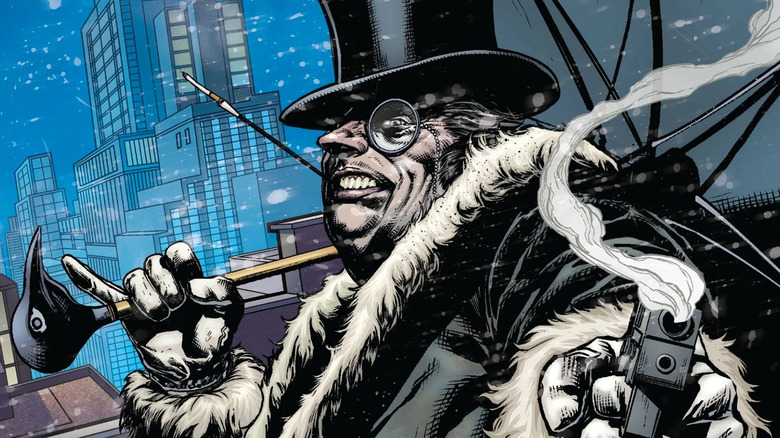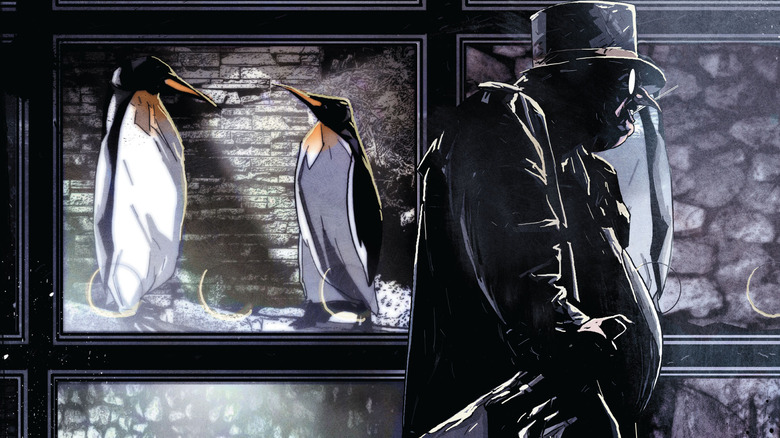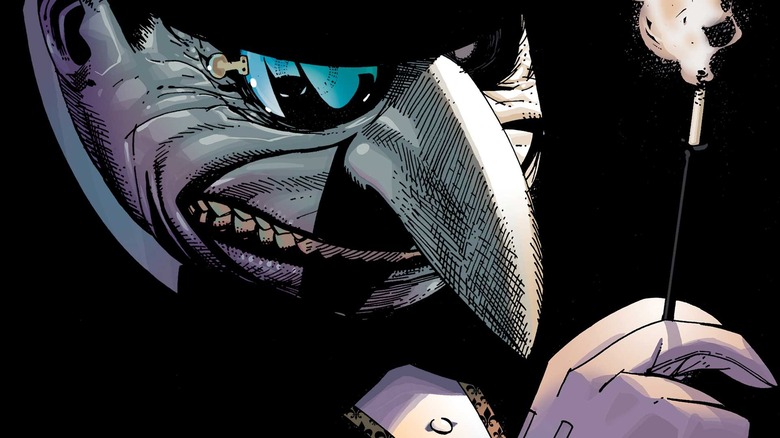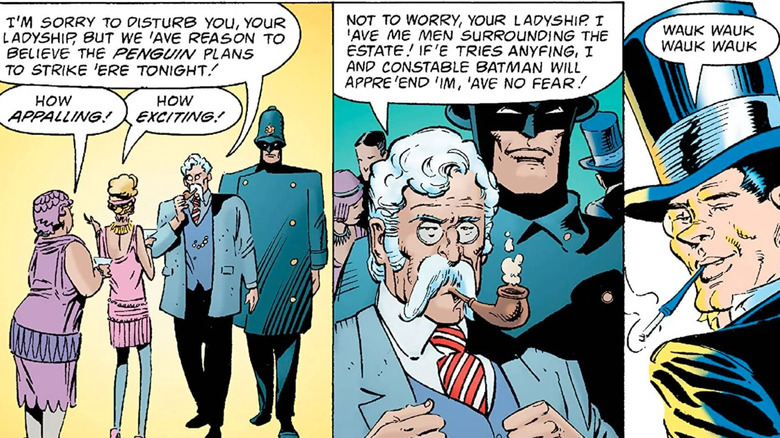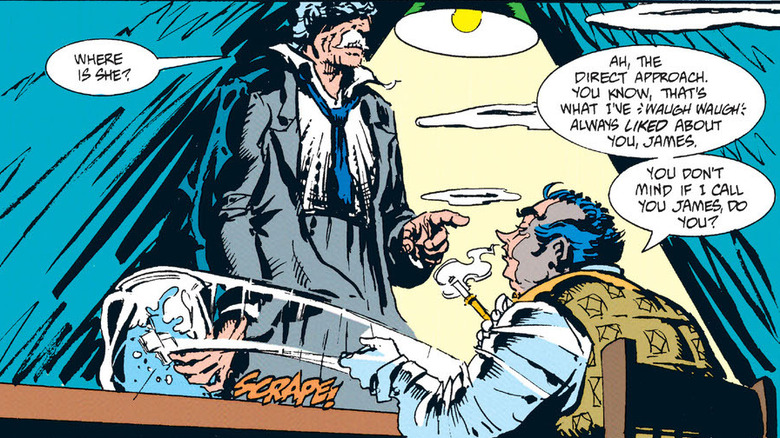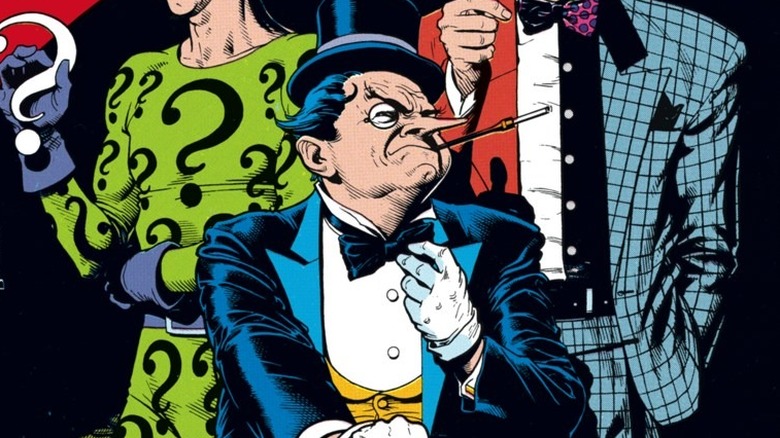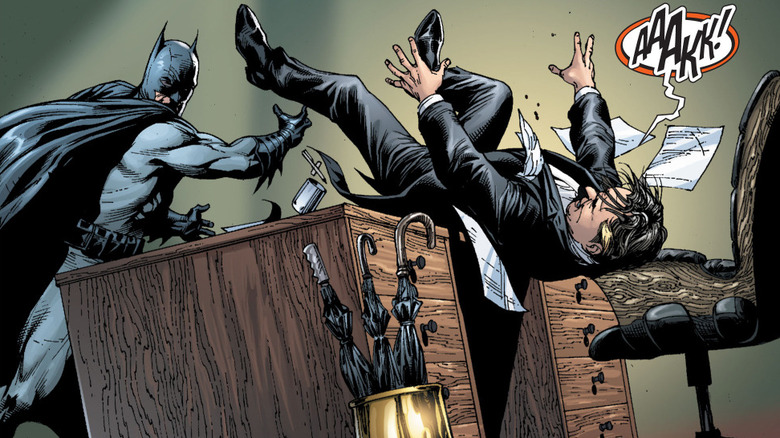The Best Penguin Comics Of All Time
Batman has a better rogues' gallery than most any other DC hero. One of the most easily recognizable of these classic villains is Oswald Cobblepot, AKA the Penguin. Like Batman himself, the Penguin was created by Bob Kane and Bill Finger. He debuted in "Detective Comics" #58 in 1941. This criminal mastermind is known for both his love of birds and his trick umbrellas, which do far more than protect him from the rain. Aside from his trademark umbrella, he's rarely seen without his top hat, monocle, and cigarette holder — though he won't have one of those in "The Batman."
The Penguin was unforgettably portrayed in the "Batman" TV series by Burgess Meredith, but his wasn't the only iconic on-screen version of this character. Perhaps his most memorable iteration was Danny DeVito in "Batman Returns," though Robin Lord Taylor put his stamp on Cobblepot in "Gotham" as well. The Penguin also appears in the new movie "The Batman," played by an unrecognizable Collin Farrell — he's even getting his own spin-off.
With the Penguin back in the spotlight in Matt Reeves' new Bat-film, it's a good time to check out some of the Penguin's best comics. Like many of Batman's villains, and even the Dark Knight himself, going far back into the history of the character yields some memorable stories — though Cobblepot has gone through quite an evolution since then. The truth is some of the Penguin's early narratives haven't aged that well, but there are plenty of classic tales worth looking back at, even if only for the art alone.
Aside from that, while early stories do use the Penguin as an antagonist of Batman, it wasn't until many years later that he became a more fully defined character. So, let's delve into the sordid history of Oswald Cobblepot. What are the best comics featuring the Penguin? Read on to find out.
Penguin: Pain and Prejudice
This 2012 miniseries by Gregg Hurwitz and Symon Kudranski attempts to humanize the villain and shed some light on why he is the way he is. "Penguin: Pain and Prejudice" is largely successful in this, fleshing out a character who had long been fairly two-dimensional. You'll probably feel bad for the young Oswald, who was mercilessly tormented. However, this story also shows just how far the Penguin will go when he perceives someone has wronged him. Spoiler alert: It's pretty far!
Young Oswald is drawn as somewhat sympathetic, though his actions in the present far outweigh anything he suffered as a child. Kudranski's art is moody and atmospheric, painting a vivid but dark picture of a villain who was often seen in a more cartoonish way. Hurwitz's words add plenty of depth to the character, telling his tale across five well-paced issues. You probably won't finish this story liking Oswald as a person, but you will understand him better — for better or worse.
He Who Laughs Last...!
This 2008 issue from Jason Aaron and Jason Pearson was part of "Joker's Asylum," a series of one-shots focusing on Batman's villains, each told from the perspective of the Clown Prince of Crime himself. While it doesn't have the time to dig as deep into Oswald's psyche as the "Pain and Prejudice" miniseries, "Joker's Asylum: Penguin" does quite a bit of character building for a single issue. It not only shows Oswald can (sort of) have a heart, but also illustrates just how quickly a supposedly kind gesture can transform into something completely ugly, especially when the Penguin is involved.
This is another story that highlights just how monstrous the Penguin can be, proving once again that he's the only one who sees himself as "the Gentleman of Crime." Aaron doesn't have long to illustrate his points, but does so expertly, even using the Joker's vantage point to do so — and really, if Joker is telling the story, how true is it? For the most part, Pearson's art makes Oswald look very menacing, but also paints the Penguin as the sad, pathetic figure he truly is underneath all that bluster.
Penguin Triumphant
"Penguin Triumphant" is a one-shot by John Ostrander, Joe Staton, and Bob Smith released in 1992. This issue is sort of a different spin on the Penguin, one in which the crime boss decides to go legit — at least, that's how he wants it to look. Rather than just relying on the Penguin fighting Batman, some of the focus here is on Oswald Cobblepot taking on Bruce Wayne, one legitimate businessman against another. What could possibly go wrong? Of course, it's just another of Oswald's schemes, which sets him firmly in Batman's crosshairs.
Ostrander, probably best known for creating the modern version of the Suicide Squad, makes no attempt at humanizing the vile villain, which is just fine. The story even begins with a delightful dream sequence that I kind of wish had gone on longer. Taking place in London, it casts Oswald as a dashing criminal, with Jim Gordon bumbling around after him, and Batman as a bobby! The art from Staton and Smith is so lighthearted and fun, really suiting the narrative perfectly.
Cracks
"Cracks" is a story in "Showcase '94" #7 which focuses on the mental gymnastics between Jim Gordon and the Penguin after Oswald takes the commissioner's wife, Sarah, hostage. He does this in an effort to get to the truth about Batman, to prove he's dead and that an imposter has taken his place. He wasn't totally off base, considering it was someone else behind the cape and cowl other than Bruce Wayne: Jean-Paul Valley. (The '90s were a weird time in comics.) Like most of the Dark Knight's villains, the Penguin is completely obsessed with him and would do anything to find out what happened, including killing Sarah. Written by the incomparable Peter David, this issue has excellent art from P. Craig Russell and Michael T. Gilbert. It's a really solid story that quickly gets to the heart of everyone involved, not just the Penguin and the acting Batman, but also Jim Gordon himself.
The Killing Peck
"The Killing Peck" is a story from "Secret Origins Special" Vol. 2 #1 that came out in 1989. While this is a strong story from Alan Grant, it's worth a read for the art alone. This tale was drawn by Sam Kieth, who went on to create "The Maxx" a few years later — though the cover image above is by the amazing Brian Bolland. Kieth was also drawing the first issues of "The Sandman" around this time. The artist was still perfecting his beautiful yet eerie style, and it really takes center stage in this tale that focuses on Cobblepot tormenting his childhood bully while trying to remain one step ahead of Batman. It's a small-scale Penguin story that encapsulates the villain incredibly well.
But this isn't Grant's only solid Penguin story. He wrote "Snow and Ice" as well, which ran in "Detective Comics" #610-611, also released in '89. Drawn by Norm Breyfogle, that narrative saw the Penguin fake his own death, though it certainly doesn't go the way he planned. Consider that a bonus recommendation.
Earth One
The Earth One series of graphic novels sought to revamp classic characters, including Batman, Superman, and Wonder Woman. They took place on another Earth and therefore didn't interfere with DC's already complicated continuity. Released in 2012, "Batman: Earth One," by Gary Frank and Geoff Johns, may have been retelling Batman's backstory yet again, but it did so exceptionally well. It's a quick, engaging read, and as usual, Frank's art is great.
While the Penguin is only a small part of this tale, his role is very important. Oswald Cobblepot is not only the mayor of Gotham, but also the man Bruce Wayne suspects of having murdered his parents. One of the more interesting things about this story is the reimagining of these characters we already know so well. Alfred, in particular, got a pretty awesome update, and this was a rare chance to see a Batman who had not yet perfected his persona. I won't spoil whether or not he was right about the Penguin being responsible for his parents' death. You'll just have to read to find out!
